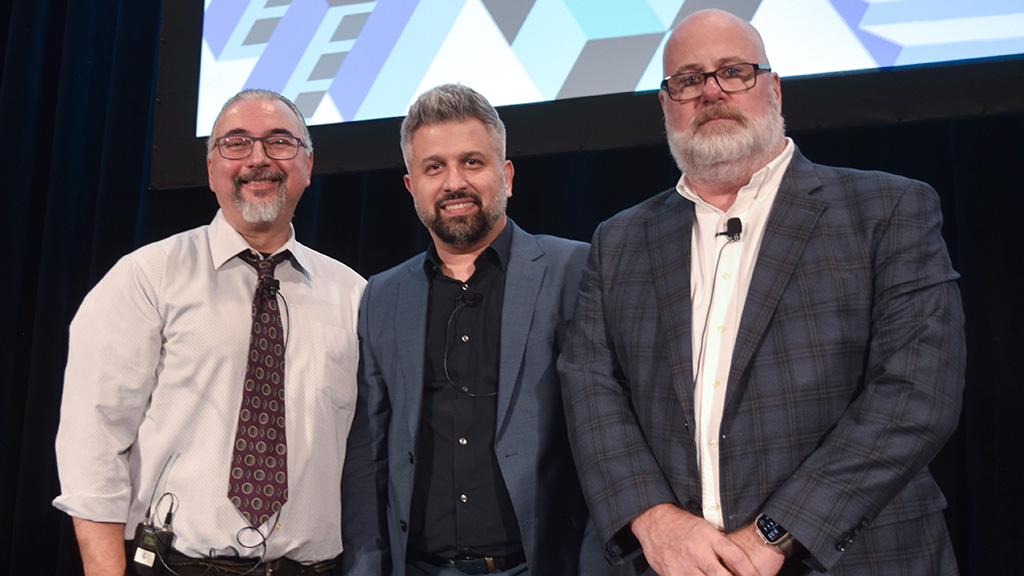Conversations on the potential uses of Artificial Intelligence in construction are becoming more enlightened with each passing month, experts on the technology told delegates attending a Buildings Show session in Toronto recently.
Not long ago, AI was still being defined and builders were being told it would either boost the economy tenfold or else it would take everyone’s job, said panellist Doug Dockery, chief technology officer at ����ӰԺ.
Now the understanding is more sophisticated but by next year at this time, he predicted, the adoption of AI will have taken another quantum leap.
“AI exists in your life now, and it hasn’t taken your job and it hasn’t killed you,” said Dockery. “But it’s made you a lot more productive. If you look at the way that AI is being used in construction now, it isn’t being used to replace people or replace roles. It’s being used to augment people and make them more efficient.”
Dockery was joined on the panel by Arash Shahi, CEO of LandLogic. The Nov. 29 session was moderated by Vince Versace, director of news media for ����ӰԺ, with the discussion billed as AI, is the Hype Real?
“When we talk about AI, particularly in the construction space, we talked about AI being able to take mundane tasks, counting things, measuring things, finding things, and removing that from the work that the humans have to do, so people can do more valuable work, so they can do things that matter,” Dockery explained.
Shahi compared the advent of AI with the Industrial Revolution, with machines being introduced to do the work humans no longer wanted to do.
“We see AI doing the same thing,” he said. “In this digital revolution, you’re going to see a lot of tools that can make your data analytics jobs a lot easier, getting data accessible to the masses. That to me is the most important contribution.”
Both Dockery and Shahi said AI is not really new, it is merely a more advanced iteration of familiar computer applications.
“AI is already embedded in a number of tools you’re using, both within the industry and outside,” said Shahi. “So I think it’s just acknowledging the fact that we have AI available to us and being able to communicate, ‘What is your need?’
“There’s a handful of organizations that can help you build that AI capability into your day to day.”
Shahi works with the real estate community, where ChatGPT functionality has the potential for tremendous breakthroughs, he said. Having access to historical and current real estate data and information from numerous sources such as conservation authorities, combined with AI accessibility, will revolutionize that sector.
“‘Tell me how much this house is worth? Or, how much can I rent this property for? Or, what can I build on this parcel of land?’ These are the questions that AI can bring in,” said Shahi.
The panellists also agreed the first step for constructors who are not yet familiar with AI is to just wade in.
“My one recommendation is to test it out,” said Shahi. “With AI, the more you use it, the more useful it becomes.”
Dockery added, “The first thing I would tell you to do is find an AI tool that’s free and play with it.”
Versace noted that across North America, some 70 per cent of firms in the construction sector have two to 20 people on staff. He asked the panellists, will they be at a disadvantage in adopting AI compared with larger firms with more resources?
Shahi said no, that AI will democratize the sector with smaller firms being able to undertake many more tasks than previously. Dockery said AI will help small firms appear larger, more professional and more capable and will allow them to win more deals.
“The idea of a two-person firm that can now spin up employees in the cloud, that go and do things that make me appear to be a 50-person firm, is a really interesting place to be,” said Dockery.
A key step to widespread adoption in the construction sector, Dockery said, is to remove the technology barrier.
If firms encounter a special vocabulary with an unapproachable interface, they will hesitate.
“We solve that problem with what’s commonly called natural language processing,” he said. “Instead of clicking a bunch of buttons or creating a filter or writing a search string and whatever, I could just say, ‘How many construction projects are happening in Cincinnati, Ohio today that require a plumber that are going to use this kind of tooling or fixtures?’”
Follow the author on Twitter .








Recent Comments
comments for this post are closed